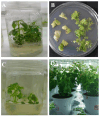Genetic Transformation of Torenia fournieri L. with the Bacillus thuringiensis Cry1Ab Gene Confers Resistance to Mythimna separata (Walker)
- PMID: 39771266
- PMCID: PMC11678925
- DOI: 10.3390/plants13243568
Genetic Transformation of Torenia fournieri L. with the Bacillus thuringiensis Cry1Ab Gene Confers Resistance to Mythimna separata (Walker)
Abstract
Torenia fournieri L. is a popular ornamental plant in the genus Torenia, widely used in commercial landscaping, especially during the summer. Additionally, Torenia has served as a model ornamental plant in many studies exploring ornamental characteristics and pest control through genetic engineering. To date, no research has been reported on developing insect-resistant Torenia expressing genes from Bacillus thuringiensis (Bt). In this study, a recombinant vector carrying the Cry1Ab gene from Bt, pBI121-Cry1Ab, was constructed and transferred into T. fournieri via Agrobacterium tumefaciens-mediated transformation. A total of 13 shoots survived on the kanamycin selection medium, among which four putative transgenic lines, designated L1, L2, L7, and L11, were molecularly confirmed by PCR and Southern blot analysis, indicating successful integration of the Cry1Ab gene into the genomes of these lines. Quantitative real-time PCR and ELISA results further verified the successful expression of the Cry1Ab gene in the leaves of all four transgenic lines. Insect bioassay results demonstrated that all four transgenic lines showed strong resistance to the insect pest, Mythimna separata, with mortality rates ranging from 59.9% to 100.0%, in contrast to a larval mortality rate of 16.2% in the wild-type Torenia. Additionally, these transgenic lines significantly decreased in larval survival rates compared to those fed on wild-type plants. Furthermore, these transgenic lines activated superoxide dismutase (SOD) activity at 12 and 24 h, and catalase (CAT) activity at 72 h, while suppressing SOD activity at 72 h, and peroxidase (POD) activity over time. Our findings indicate that these transgenic lines exhibit high resistance to the insect pest and provide new insights into controlling insect pests in ornamental plants through genetic approaches.
Keywords: Cry1Ab; insect resistance; oriental armyworm; protective enzymes; transgenic Torenia.
Conflict of interest statement
The authors declare no conflicts of interest.
Figures







Similar articles
-
Transgenic tomato line expressing modified Bacillus thuringiensis cry1Ab gene showing complete resistance to two lepidopteran pests.Springerplus. 2014 Feb 12;3:84. doi: 10.1186/2193-1801-3-84. eCollection 2014. Springerplus. 2014. PMID: 24600542 Free PMC article.
-
Bt Jute Expressing Fused δ-Endotoxin Cry1Ab/Ac for Resistance to Lepidopteran Pests.Front Plant Sci. 2018 Jan 4;8:2188. doi: 10.3389/fpls.2017.02188. eCollection 2017. Front Plant Sci. 2018. PMID: 29354143 Free PMC article.
-
Insecticidal Effects of Transgenic Maize Bt-Cry1Ab, Bt-Vip3Aa, and Bt-Cry1Ab+Vip3Aa against the Oriental Armyworm, Mythimna separata (Walker) in Southwest China.Toxins (Basel). 2024 Mar 4;16(3):134. doi: 10.3390/toxins16030134. Toxins (Basel). 2024. PMID: 38535800 Free PMC article.
-
A cadherin-like protein influences Bacillus thuringiensis Cry1Ab toxicity in the oriental armyworm, Mythimna separata.Environ Microbiol Rep. 2013 Jun;5(3):438-43. doi: 10.1111/1758-2229.12036. Epub 2013 Feb 17. Environ Microbiol Rep. 2013. PMID: 23754724
-
Insect pathogens as biological control agents: Back to the future.J Invertebr Pathol. 2015 Nov;132:1-41. doi: 10.1016/j.jip.2015.07.009. Epub 2015 Jul 27. J Invertebr Pathol. 2015. PMID: 26225455 Review.
References
Grants and funding
LinkOut - more resources
Full Text Sources
Miscellaneous

